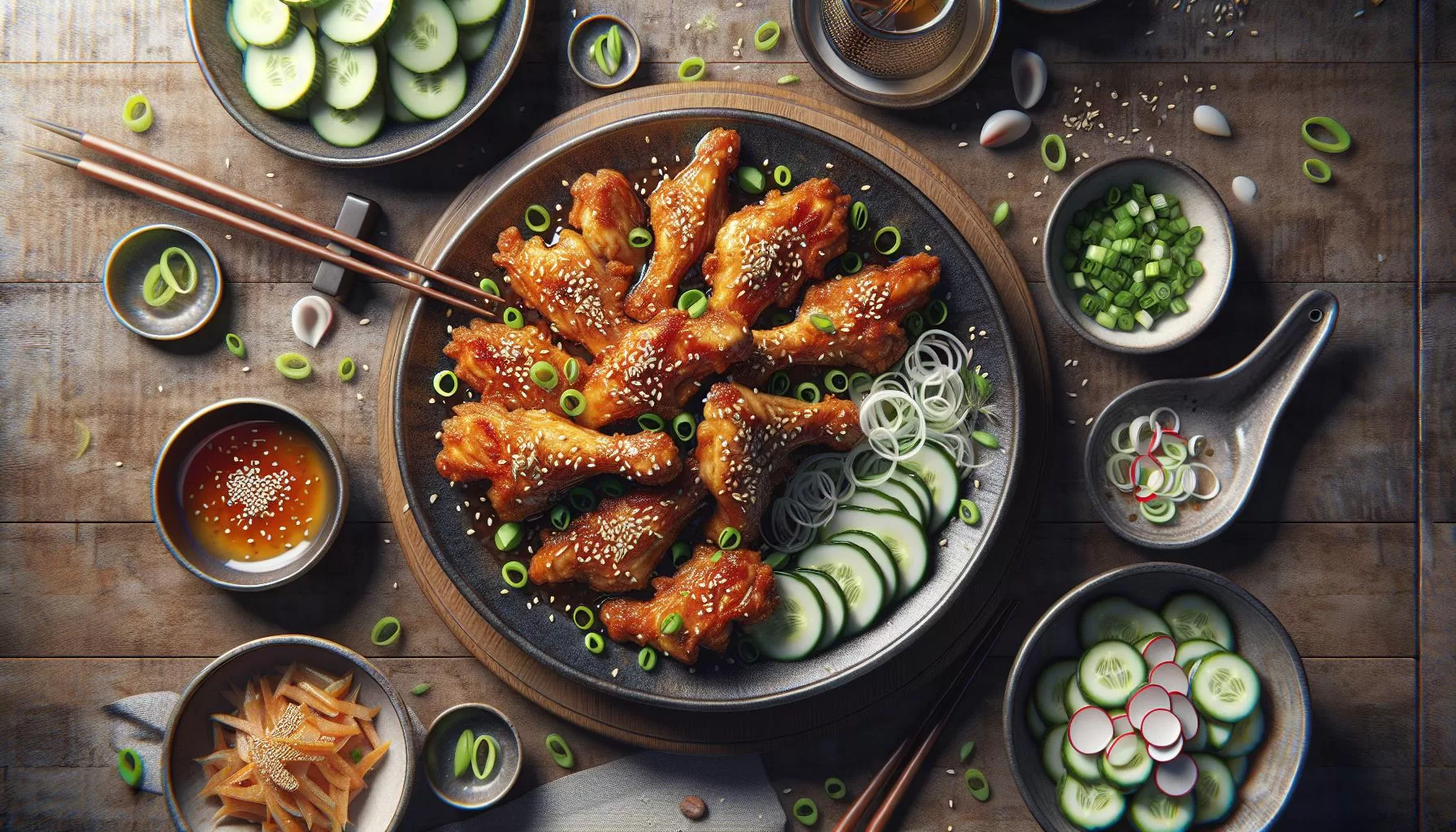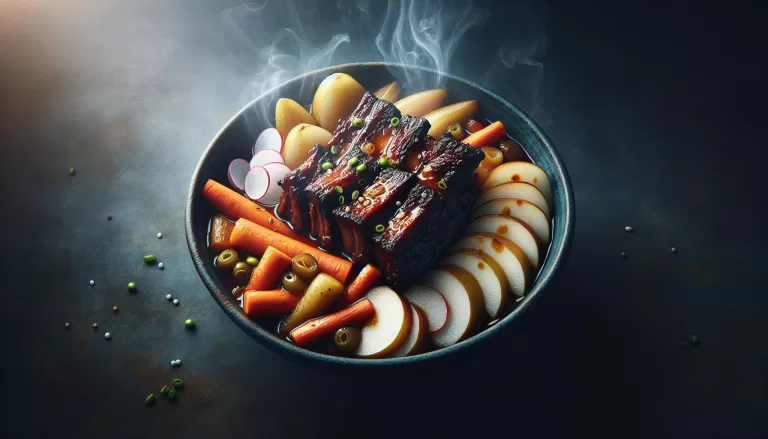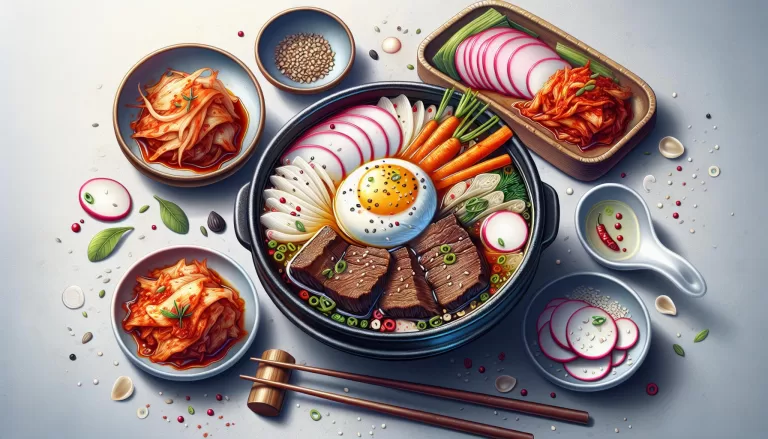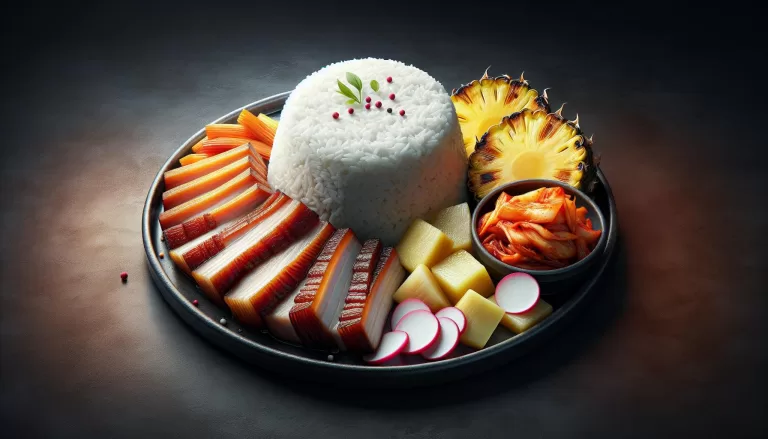Easy Homemade Dakgangjeong Recipe – Sweet Crispy Korean Chicken

Ingredients for Homemade Dakgangjeong Sweet Crispy Chicken
Turning your kitchen into a taste hub for delicious Korean cuisine starts with the right ingredients. Your DIY Dakgangjeong would require some specifically selected components to transform simple chicken into a sweet, spicy and crispy burst of flavors.
You’ll need:
- Chicken thighs (1.5 lbs)
- Starch powder (1/2 cup)
- Soy sauce (3 tablespoons)
- White vinegar (2 tablespoons)
- Honey (1/3 cup)
- Brown sugar (1/4 cup)
- Korean chili paste (Gochujang) (1 tablespoon)
- Garlic (3 cloves, finely minced)
- Sesame oil (1 teaspoon)
- Sesame seeds (for garnish)
- Spring onions (for garnish)
Chicken thighs are preferable because they offer juiciness that no other part matches. An efficient substitute, if required, would be chicken breast. On the other hand, the starch powder amplifies the crispiness while also acting as a binding agent for our sauce.
The crowd pleasure remains in the sauce. You’ll mix the soy sauce, white vinegar, honey, brown sugar, Gochujang and garlic together to create a tangy, sweet and spicy fusion. A little tip here: switch up white vinegar with apple cider for an extra fruity zing!
Imagine cooking the chicken and it’s not as aromatic as you’d like it to be. Here’s our hack – a drizzle of sesame oil as we take the chicken off the heat. You wouldn’t just smell the difference – you’d taste it too.
To finish, sprinkle sesame seeds and scatter some chopped spring onions over your Dakgangjeong and voila! Your homemade delight is ready to be devoured.
As a heads up on the nutrition front, a serving of Dakgangjeong carries approximately 332 calories, 16g of protein, 15g of fat, and 37g of carbohydrates. Include this data as part of your meal planning, especially if you’re tracking your nutritional intake.
Step-by-Step Instructions for Making Dakgangjeong

Prepping the Chicken
Begin with choosing high-quality chicken thighs for your Dakgangjeong. You’ll find thighs offer more flavorful, juicy meat than chicken breasts. Cut the chicken thighs into bite-sized pieces and sprinkle them with a small amount of salt.
Next, you’ll coat your chicken with starch powder. A nice layer of starch powder ensures your chicken gets nice and crispy when cooked.
Frying Your Chicken
No good Dakgangjeong comes without a proper fry. You’ll want to heat your oil in a large frying pan or deep-fryer. Once the oil has reached the right temperature – around 330°F (165°C) – gently drop in your chicken pieces. Remember, don’t overcrowd the pan.
It’s advisable to double-fry your chicken. This indeed makes it extra crispy. So, remove the chicken after it’s lightly browned, let it rest, then fry again until golden brown.
Crafting Your Sauce
While your chicken is resting, it’s time to whip up your sauce. Combine soy sauce, honey, Gochujang, and garlic in a pan. Simmer these ingredients until your sauce starts to thicken. If you’d like to add an unusual kick, consider experimenting with a splash of apple cider vinegar.
Bringing It All Together
Once your sauce has thickened, add your double-fried chicken. Stir until each piece is thoroughly coated. To further pronounce the flavors, try drizzling a bit of sesame oil.
Finishing Touches
For the final steps, garnish your Dakgangjeong with necessarily sesame seeds and finely chopped spring onions. You’ll find these additions provide not only a lovely visual aspect, but they also enrich the overall taste.
| Nutrient | Amount |
|---|---|
| Calories | 250-400 |
| Carbs | 20-30g |
| Protein | 15-20g |
Tips for Perfecting Your Dakgangjeong Recipe

No matter how precise a recipe is, there’s always room for a little personal touch or tweak to make a dish truly your own. With dakgangjeong, you’re free to experiment until you master the perfect balance of flavors that suits your palate.
Choose Quality Ingredients
Remember, your dakgangjeong’s final taste hinges on the quality of your ingredients. Ensure you’re picking fresh, plump chicken thighs for maximum juiciness. If you’re substituting starch powder to achieve that irresistible crunch, consider using potato or tapioca starch. They can produce an even crispier texture than regular corn or wheat starch.
Getting the Sauce Just Right
Getting the sauce right is key to amazing dakgangjeong. You might want to try simmering it a bit longer for a richer, deeper flavor. Adding a touch of apple cider vinegar can bring an unexpected yet delightful tang. But remember, moderation is essential here.
Optimal Frying Techniques
You’re probably aware that the double-frying method is a game-changer for that flawless crispy exterior. For the first fry, keep the oil temperature low around 330°F. This process cooks the chicken through without burning the outer layer. After resting the pieces, crank up the heat, to about 375°F, for the second fry to achieve that golden, crunchy exterior.
Tailoring The Dish To Needs
While dakgangjeong is undeniably scrumptious, maintaining balance in your diet is equally important. If you’re concerned about the carb content, replace honey with a sugar substitute or reduce the volume used.
| Nutrition Facts | Per Serving |
|---|---|
| Calories | 287 |
| Carbs | 20.5g |
| Protein | 26.5g |
Lastly, don’t forget the finishing touches. Drizzle sesame oil over your chicken for added depth of flavor and sprinkle generously with sesame seeds and freshly chopped spring onions. It’s these details that take your dakgangjeong from satisfying to spectacular.
Serving and Enjoying Your Homemade Dakgangjeong

When it comes to serving your delicious dakgangjeong, it’s a display of personal taste and creativity. Presentation is key in making your dish not only taste great but also look appealing. Usually, it’s served in a shallow bowl or on a plate, garnished with sesame seeds and chopped spring onions. But the serving style can be tailored to your preference.
For an authentic experience, serve your homemade dakgangjeong with classic Korean sides. Considering light fare such as cucumber salad or lightly pickled radishes will complement the dish by offering a refreshing contrast to the dish’s sweet and crispy elements.
Highlighting Nutritional Value, it’s worth noting that while this dish is rich in flavors, it also carries a hefty amount of calories due to the deep frying process and the sweet sauce. The importance of mindful eating comes into play here. Balance it out with light and nutritious sides, keeping portion sizes in check.
| Nutritional Component | Value per serving |
|---|---|
| Calories | 450 kcal |
| Carbs | 30g |
| Protein | 24g |
| Fat | 20g |
| Vitamins | A, B6, B12, E |
Your homemade dakgangjeong isn’t just about what you’re putting in your stomach but it’s about the whole process of the cooking journey. It’s sharing food and love with your family and friends.
Remember, there’s no right or wrong when it comes to enjoying your dakgangjeong. Whether you prefer it as a main dish with hot steamed rice or enjoy it as a crispy snack with a beverage, your homemade dakgangjeong suits it all. Carry forward the fun aspect of trying new garnishes, pair it with various sides, switch up your serving style, and most importantly relish the flavors and the joy of homemade cooking.
There you have it. The charm is in the exploration. Enjoy the journey and savor the destination. The dakgangjeong adventure continues.
Conclusion
You’ve journeyed through the art of making homemade Dakgangjeong and learned how to serve it with flair. It’s clear this dish isn’t just about the sweet crispy chicken but the whole experience. It’s about pairing it with the right sides, garnishing it to your liking, and practicing portion control. Remember, while the calorie count might be high, it’s okay to indulge once in a while. So next time you’re in the kitchen, get creative with your Dakgangjeong. Experiment with different sides and garnishes. Enjoy the process and share the joy of homemade cooking. Because making Dakgangjeong isn’t just about eating. It’s about creating memories around the dining table. And that’s what truly makes it special.





